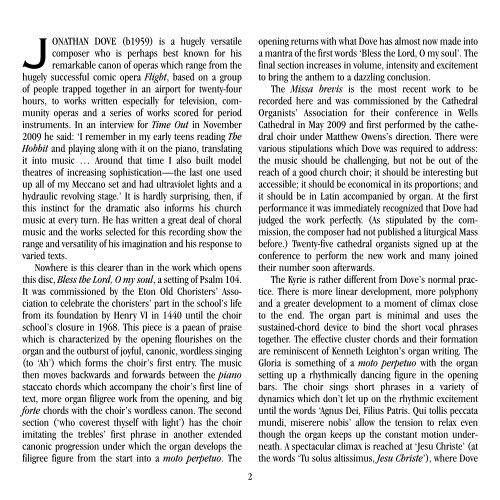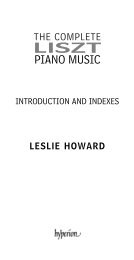CHORAL MUSIC BY JONATHAN DOVE - Abeille Musique
CHORAL MUSIC BY JONATHAN DOVE - Abeille Musique
CHORAL MUSIC BY JONATHAN DOVE - Abeille Musique
You also want an ePaper? Increase the reach of your titles
YUMPU automatically turns print PDFs into web optimized ePapers that Google loves.
<strong>JONATHAN</strong> <strong>DOVE</strong> (b1959) is a hugely versatile<br />
composer who is perhaps best known for his<br />
remarkable canon of operas which range from the<br />
hugely successful comic opera Flight, based on a group<br />
of people trapped together in an airport for twenty-four<br />
hours, to works written especially for television, community<br />
operas and a series of works scored for period<br />
instruments. In an interview for Time Out in November<br />
2009 he said: ‘I remember in my early teens reading The<br />
Hobbit and playing along with it on the piano, translating<br />
it into music … Around that time I also built model<br />
theatres of increasing sophistication—the last one used<br />
up all of my Meccano set and had ultraviolet lights and a<br />
hydraulic revolving stage.’ It is hardly surprising, then, if<br />
this instinct for the dramatic also informs his church<br />
music at every turn. He has written a great deal of choral<br />
music and the works selected for this recording show the<br />
range and versatility of his imagination and his response to<br />
varied texts.<br />
Nowhere is this clearer than in the work which opens<br />
this disc, Bless the Lord, O my soul, a setting of Psalm 104.<br />
It was commissioned by the Eton Old Choristers’ Association<br />
to celebrate the choristers’ part in the school’s life<br />
from its foundation by Henry VI in 1440 until the choir<br />
school’s closure in 1968. This piece is a paean of praise<br />
which is characterized by the opening flourishes on the<br />
organ and the outburst of joyful, canonic, wordless singing<br />
(to ‘Ah’) which forms the choir’s first entry. The music<br />
then moves backwards and forwards between the piano<br />
staccato chords which accompany the choir’s first line of<br />
text, more organ filigree work from the opening, and big<br />
forte chords with the choir’s wordless canon. The second<br />
section (‘who coverest thyself with light’) has the choir<br />
imitating the trebles’ first phrase in another extended<br />
canonic progression under which the organ develops the<br />
filigree figure from the start into a moto perpetuo. The<br />
2<br />
opening returns with what Dove has almost now made into<br />
a mantra of the first words ‘Bless the Lord, O my soul’. The<br />
final section increases in volume, intensity and excitement<br />
to bring the anthem to a dazzling conclusion.<br />
The Missa brevis is the most recent work to be<br />
recorded here and was commissioned by the Cathedral<br />
Organists’ Association for their conference in Wells<br />
Cathedral in May 2009 and first performed by the cathedral<br />
choir under Matthew Owens’s direction. There were<br />
various stipulations which Dove was required to address:<br />
the music should be challenging, but not be out of the<br />
reach of a good church choir; it should be interesting but<br />
accessible; it should be economical in its proportions; and<br />
it should be in Latin accompanied by organ. At the first<br />
performance it was immediately recognized that Dove had<br />
judged the work perfectly. (As stipulated by the commission,<br />
the composer had not published a liturgical Mass<br />
before.) Twenty-five cathedral organists signed up at the<br />
conference to perform the new work and many joined<br />
their number soon afterwards.<br />
The Kyrie is rather different from Dove’s normal practice.<br />
There is more linear development, more polyphony<br />
and a greater development to a moment of climax close<br />
to the end. The organ part is minimal and uses the<br />
sustained-chord device to bind the short vocal phrases<br />
together. The effective cluster chords and their formation<br />
are reminiscent of Kenneth Leighton’s organ writing. The<br />
Gloria is something of a moto perpetuo with the organ<br />
setting up a rhythmically dancing figure in the opening<br />
bars. The choir sings short phrases in a variety of<br />
dynamics which don’t let up on the rhythmic excitement<br />
until the words ‘Agnus Dei, Filius Patris. Qui tollis peccata<br />
mundi, miserere nobis’ allow the tension to relax even<br />
though the organ keeps up the constant motion underneath.<br />
A spectacular climax is reached at ‘Jesu Christe’ (at<br />
the words ‘Tu solus altissimus, Jesu Christe’), where Dove
















